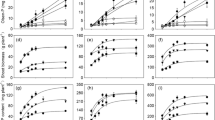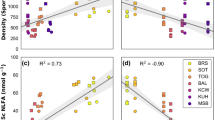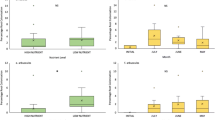Abstract
Primary production in terrestrial ecosystems is sustained by plants, microbiota, and fungi, which are the major organic matter providers in the root zone, setting in motion the soil food webs. Predators like soil amoebae voraciously feed on bacteria, fungi, and microbial eukaryotes releasing the nutrients sequestered in their biomass. Early food web setting up is crucial for seedling nutrition and its further development after establishment. Mycorrhizal fungi are more than phosphorus providers, and we wonder what their role is in structuring the predators’ trophic groups in the root zone. We evaluated the effect of Rhizophagus intraradices inoculated in Zea mays (mycorrhizosphere), on the structuration of amoebae trophic groups along vertical and horizontal (3, 6, and 9 cm) soil distribution when compared to un-inoculated plants, after 20 days in microcosms. Amoebae species richness was highest in non-mycorrhizal seedlings in the root zone at 6- to 9-cm depth, and 3 cm away from plants. More bacterial species are needed when plants are devoid of mycorrhiza, and their influence is constrained 3 cm away from roots. Higher diversity of trophic groups was recorded at mycorrhizal seedlings and at the compartment influenced by the mycelium at 6- to 9-cm depth. The highest bacterivorous diversity, higher number of rare species and protozoa-eating amoebae, and the absence of fungivorous group recorded at the mycorrhizosphere of Z. mays, indicate that the community was very different from the non-mycorrhizal plants. We conclude that the arbuscular mycorrhizal fungus exerts significant changes on the community of trophic groups of amoebae.






Similar content being viewed by others
References
Levin SA (2005) Self-organization and the emergence of complexity in ecological systems. Bioscience 55:1075–1079. https://doi.org/10.1641/0006-3568(2005)055[1075:SATEOC]2.0.CO;2
Bonkowski M, Jentschke G, Scheu S (2001) Contrasting effects of microbes in the rhizosphere: interactions of mycorrhiza (Paxillus involutus (Batsch) Fr.), naked amoebae (Protozoa) and Norway spruce seedling (Picea abies Karst.). Appl Soil Ecol 18:193–204. https://doi.org/10.1016/S0929-1393(01)00165-2
Finlay R, Rosling A (2006) Integrated nutrient cycles in boreal forest ecosystems – the role of mycorrhizal fungi. In G. Gadd (Ed.), Fungi in biogeochemical cycles (British Mycological Society Symposia, pp. 28-50). Cambridge: Cambridge University Press. https//doi.org/10.1017/CBO9780511550522.003
Srnith SE, Smith EA (2012) Fresh perspectives on the roles of arbuscular mycorrhizal fungi in plant nutrition and growth. Mycologia 104(1):1–13. https://doi.org/10.3852/11-229
Smith SE, Gianinazzi-Pearson V (1988) Physiological interactions between symbionts in vesicular–arbuscular mycorrhizal plants. Annu Rev Plant Physiol 39:221–244. https://doi.org/10.1146/annurev.pp.39.060188.001253
Nuccio EE, Hodge A, Pett-Ridge J, Herman DJ, Weber PK, Firestone MK (2013) An arbuscular mycorrhizal fungus significantly modifies the soil bacterial community and nitrogen cycling during litter decomposition. Environ Microbiol 15:1870–1881. https://doi.org/10.1111/1462-2920.12081
Andrade G, Mihara KL, Linderman RG, Bethlenfalvay GJ (1997) Bacteria from rhizosphere and hyphosphere soils of different arbuscular-mycorrhizal fungi. Plant Soil 192:71–79. https://doi.org/10.1023/A:1004249629643
Horii S, Ishii T (2006) Identification and function of Gigaspora margarita growth-promoting microorganisms. Symbiosis 41:135–141
Horii S, Matsumura A, Cruz A, Ishii T (2008) Effect of arbuscular mycorrhizal fungi and their helper microorganisms on root colonization and growth of trifoliate orange seedlings. Proc Int Soc Citriculture 1:567–571
Scheublin TR, Sanders IR, Keel C, van der Meer JR (2010) Characterisation of microbial communities colonizing the hyphal surfaces of arbuscular mycorrhizal fungi. ISME J 4:752–763. https://doi.org/10.1038/ismej.2010.5
Frey-Klett P, Garbaye J, Tarkka M (2007) The mycorrhiza helper bacteria revisited. New Phytol 176:22–36. https://doi.org/10.1111/j.1469-8137.2007.02191.x
Battini F, Grønlund M, Agnolucci M, Giovannetti M, Jakobsen I (2017) Facilitation of phosphorus uptake in maize plants by mycorrhizosphere bacteria. Sci Rep 7:46–86. https://doi.org/10.1038/s41598-017-04959-0
Svenningsen NB, Watts-Williams SJ, Joner EJ, Battini F, Efthymiou A, Cruz-Paredes C, Nybroe O, Jakobsen I (2018) Suppression of the activity of arbuscular mycorrhizal fungi by the soil microbiota. ISME J 12:1296–1307. https://doi.org/10.1038/s41396-018-0059-3
Klein E, Ofek M, Katan J, Minz D, Gamliel A (2012) Soil suppressiveness to Fusarium disease: shifts in root microbiome associated with reduction of pathogen root colonization. Phytopathology 103:23–33. https://doi.org/10.1094/PHYTO-12-11-0349
Liu X, Zhang S, Jiang Q, Bai Y, Shen G, Li S, Ding W (2016) Using community analysis to explore bacterial indicators for disease suppression of tobacco bacterial wilt. Sci Rep 6:36773. https://doi.org/10.1038/srep36773
Clarholm M (1981) Protozoan grazing of bacteria in soil—impact and importance. Microb Ecol 7:343–350. https://doi.org/10.1007/BF02341429
Darbyshire JF (1994) Soil protozoa. CABI Publishing Series. Colaborador C.A.B. International, Michigan University
Odelade KA, Babalola OO (2019) Bacteria, fungi and archaea domains in rhizospheric soil and their effects in enhancing agricultural productivity. Int J Environ Res Public Health 16:3873. https://doi.org/10.3390/ijerph16203873
Leach JE, Triplett LR, Argueso CT, Trivedi P (2017) Communication in the Phytobiome. ISSUE 4:587–596. https://doi.org/10.1016/j.cell.2017.04.025
Baltar F, Palovaara J, Unrein F, Catala P, Horňák K, Šimek K, Vaqué D, Massana R, Gasol JM, Pinhassi J (2016) Marine bacterial community structure resilience to changes in protist predation under phytoplankton bloom conditions. ISME J 3:568–581. https://doi.org/10.1038/ismej.2015.135
Wootton EC, Zubkov MV, Jones DH, Jones RH, Martel CM, Thornton CA, Roberts EC (2007) Biochemical prey recognition by planktonic protozoa. Environ Microbiol 1:216–222. https://doi.org/10.1111/j.1462-2920.2006.01130.x
Clarholm M (2002) Bacteria and protozoa as integral components of the forest ecosystem—their role in creating a naturally varied soil fertility. Antonie Van Leeuwenhoek. https://doi.org/10.1023/a:1020543424098
Griffiths BS (1994) Microbial-feeding nematodes and protozoa in soil: their effects on microbial activity and nitrogen mineralization in decomposition hotspots and the rhizosphere. Plant Soil 164:25–33. https://doi.org/10.1007/BF00010107
Ichinotsuka D, Ueno H, Nakano S (2006) Relative importance of nanoflagellates and ciliates as consumers of bacteria in a coastal sea area dominated by oligotrichous Strombidium and Strobilidium. Aquat Microb Ecol 42:139–147. https://doi.org/10.3354/ame042139
Shaulsky G, Kessin RH (2007) The cold war of the social amoebae. Curr Biol 16:684–692. https://doi.org/10.1016/j.cub.2007.06.024
Cortés-Pérez S, Rodríguez-Zaragoza S, Ferrera-Cerrato R, Luna Pabello VM (2018) Recovery of amoebae community in the root soil of M. sativa after a strong contamination pulse with n-hexane. Water Air Soil Pollut 229:293. https://doi.org/10.1007/s11270-018-3944-5
Cortés-Pérez S, Rodríguez-Zaragoza S, Mendoza-López MR (2013) Trophic structure of amoeba communities near roots of Medicago sativa after contamination with fuel oil No. 6. Microbial Ecol 67:430-442. https://doi.org/10.1007/s00248-013-0305-1
Mondragón-Camarillo L, Zaragoza SR, Mendoza-López MR, Cabirol N, Macek M (2020) Recovery of soil protozoan community structure promoted by M. sativa after a strong pulse of hydrocarbon contamination. Water Air Soil Pollut 231:283. https://doi.org/10.1007/s11270-020-04618-7
Rodríguez-Zaragoza S, Dorantes I, Velasco-Velasco J, Ferrera-Cerrato R (2004) Impacto de la fumigación con bromuro de metilo en tipos morfológicos de amebas desnudas de un suelo agrícola. Terra Latinoam 22(2):197-205. https://www.redalyc.org/articulo.oa?id=57322208
Bonkowski M (2004) Protozoa and plant growth: the microbial loop in soil revisited. New Phytol 162:617–631. https://doi.org/10.1111/j.1469-8137.2004.01066.x
Bonkowski M, Clarholm M (2012) Stimulation of plant growth through interactions of bacteria and protozoa: Testing the auxiliary microbial loop hypothesis. Acta Protozool 51:237–247. https//doi.org/10.4467/16890027AP.12.019.0765
Hardacre AK, Turnbull HL (1986) The growth and development of maize (Zea mays L.) at five temperatures. Ann Bot 6:779–787. https://doi.org/10.1093/oxfordjournals.aob.a087260
Lee JJ, Soldo AT (1992) Protocols in protozoology. Society of protozoologists, Kansas
Singh BN (1975) Aerobic small free-living amoebae. In: Pathogenic and non-pathogenic amoebae. The Macmillan Press LTD, pp 1–32. https//doi.org/10.1007/978-1-349-02620-3
Phillips JM, Hayman DS (1970) Improved procedures for clearing and staining parasitic and vesicular arbuscular mycorrhizal fungi for rapid assessment of infection. Br Mycol Soc 1:158-IN18. https://doi.org/10.1016/S0007-1536(70)80110-3
Tennant D (1975) A test of a modified line intersect method of estimating root length. J of Ecol 63:995–1001. https://doi.org/10.2307/2258617
McCune B, Mefford MJ (2018) PC-ORD. Multivariate Analysis of Ecological Data. Version 7.09. Wild Blueberry Media, Corvallis, Oregon, U.S.A. https://www.wildblueberrymedia.net/
Shannon CE, Weaver W (1949) The mathematical theory of communication. University Illinois Press, Urbana
Simpson EH (1949) Measurement of diversity. Nature 163:688. https://doi.org/10.1038/163688a0
Greenwood PE (1996) A guide to chi-squared testing. JohnWiley & Sons, New York
Koleff P, Gaston KJ, Lennon JJ (2003) Measuring beta diversity for presence–absence data. J Anim Ecol 72:367–382. https://doi.org/10.1046/j.1365-2656.2003.00710.x
Birhane E, Sterck FJ, Fetene M, Bongers F, Kuyper TW (2012) Arbuscular mycorrhizal fungi enhance photosynthesis, water use efficiency, and growth of frankincense seedlings under pulsed water availability conditions. Oecologia 169:895–904. https://doi.org/10.1007/s00442-012-2258-3
Rodriguez-Zaragoza S, Mayzlish E, Steinberger Y (2005) Vertical distribution of the free-living amoeba population in soil under desert shrubs in the Negev Desert, Israel. Appl Environ Microbiol 4:2053–2060. https://doi.org/10.1128/AEM.71.4.2053-2060.2005
Filion M, St-Arnaud M, Fortin JA (1999) Direct interaction between the arbuscular mycorrhizal fungus Glomus intraradices and different rhizosphere microorganisms. New Phytol 3:525–533. https://doi.org/10.1046/j.1469-8137.1999.00366.x
George E, Marschner H, Jakobsen I (1995) Role of arbuscular mycorrhizal fungi in uptake of phosphorus and nitrogen from soil. Crit Rev Biotechnol 15:257–270. https://doi.org/10.3109/07388559509147412
Lareen A, Burton F, Schäfer P (2016) Plant root-microbe communication in shaping root microbiomes. Plant Mol Biol 6:575–587. https://doi.org/10.1007/s11103-015-0417-8
Philippot L, Raaijmakers J, Lemanceau P, Wim H (2013) Going back to the roots: the microbial ecology of the rhizosphere. Nat Rev Microbiol 11:789–799. https://doi.org/10.1038/nrmicro3109
Gao C, Montoya L, Xu L, Madera M, Hollingsworth J, Purdom E, Hutmacher RB, Dahlberg JA, Coleman-Derr D, Lemaux PG, Taylor JW (2019) Strong succession in arbuscular mycorrhizal fungal communities. ISME J 13:214–226. https://doi.org/10.1038/s41396-018-0264-0
Acknowledgements
First author acknowledges financial support from CONACyT-Mexico, during her postdoctoral position at Colegio de Postgraduados.
Author information
Authors and Affiliations
Contributions
Sandra Cortés-Pérez and Ronald Ferrera-Cerrato conceived and designed the experiments. Sandra Cortés-Pérez performed the laboratory experiments. Material preparation, data collection, and analysis were performed by Sandra Cortés-Pérez. The manuscript was written by Sandra Cortés-Pérez, and all authors commented and suggested further corrections in the manuscript. Alejandro Alarcón and Salvador Rodríguez-Zaragoza critically reviewed the final manuscript, and all authors approved the final manuscript.
Corresponding author
Ethics declarations
Ethics Approval
Not applicable.
Consent to Participate
Not applicable.
Consent for Publication
Not applicable.
Competing Interests
The authors declare no competing interests.
Rights and Permissions
Not applicable.
Additional information
Publisher’s Note
Springer Nature remains neutral with regard to jurisdictional claims in published maps and institutional affiliations.
Supplementary Information
Below is the link to the electronic supplementary material.
Rights and permissions
Springer Nature or its licensor (e.g. a society or other partner) holds exclusive rights to this article under a publishing agreement with the author(s) or other rightsholder(s); author self-archiving of the accepted manuscript version of this article is solely governed by the terms of such publishing agreement and applicable law.
About this article
Cite this article
Cortés-Pérez, S., Ferrera-Cerrato, R., Rodríguez-Zaragoza, S. et al. Short-Term Evaluation of the Spatial Distribution of Trophic Groups of Amoebae in the Rhizosphere of Zea mays Inoculated with Rhizophagus intraradices. Microb Ecol 86, 997–1009 (2023). https://doi.org/10.1007/s00248-022-02132-3
Received:
Accepted:
Published:
Issue Date:
DOI: https://doi.org/10.1007/s00248-022-02132-3




